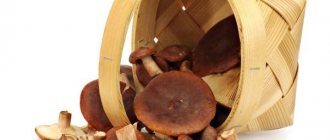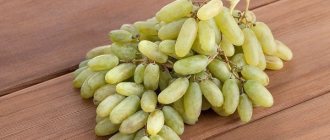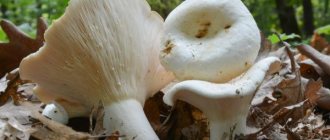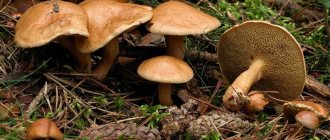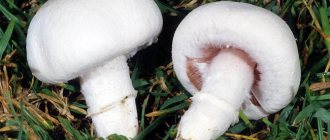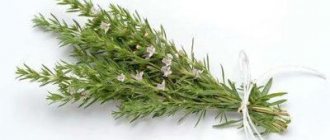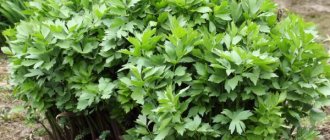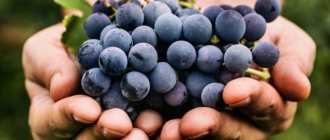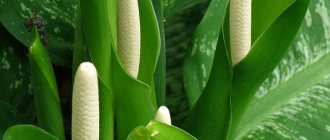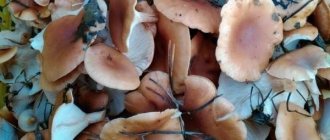The sorrel mushroom (Latin name Lactarius Volemus) is a rare guest that is found in our forests; it belongs to the genus of lamellar mushrooms, to the Russulaceae family. Finding it is quite difficult. And many mushroom pickers are confident that this specimen is inedible. If you are going to the forest to pick mushrooms, you should know what spurge looks like in case you do encounter it.
Common names: milkweed, spurge, red-brown milk mushroom.
Description of the mushroom
If you are a novice mushroom picker, before you go on a “hunt” for thistle, you should carefully read the description and photographs so as not to accidentally confuse it with other, dangerous representatives. At first glance, it looks completely normal, but upon closer examination, some features can be discerned.
What does it look like
The common mushroom is a relatively small mushroom, reaching a maximum height of about 12 cm. It is not so easy to find in the forest, since the color often blends in with the surrounding area. Looking at the photo, you can see that the mushroom has a dryish fleshy cap with a diameter of 5–15 cm. Its shape is different in young and adult representatives: at first it is convex, has a small tubercle in the middle, and in old mushrooms it is spread out with a depressed center.
The edges of the cap are initially tucked in, but with age they straighten out and become thinner. The color ranges from red-yellow to brown-red. In some regions, the mushroom is also called serushka, since its cap has a grayer tint. The leg is thick, sometimes its diameter reaches 4 cm, has a cylindrical shape, smooth or slightly swollen. The height of the stem is 4–10 cm. In young mushrooms it is fleshy, but with age it becomes hollow. To the touch - velvety, smooth. The color of the stem is most often similar to the cap, but a little lighter.
The pulp is dense, but if damaged, it breaks quickly and has a sweetish taste. Another name for thistle is milkweed (euphorbia, molokanka).
It is so called because when cut it secretes a milky sap - a white sticky liquid that changes color to brown when exposed to air. The inside of the cap is covered with yellowish or white-pink plates that darken when touched or damaged.
Euphorbia mushroom: how to cook at home
Unlike other mushrooms of the Mlechnik genus, the red-brown milk mushroom is not at all bitter. A special feature of milkweed is its specific fishy smell, which is stronger the older the mushroom is. During cooking, the smell becomes less pronounced, but still remains. Young mushrooms, unlike old ones, have a pleasant, rich taste.
It is recommended to salt and marinate the spurge mushroom, as well as fry, stew and dry it. Moreover, it does not require soaking before cooking, like other representatives of the Russula family. Euphorbia is never damaged by larvae, so some mushroom pickers prefer to consume it raw with salt.
Growing
Today, growing mushrooms in your own garden beds is very popular among gardeners. In addition to the well-known champignons and oyster mushrooms, people have learned to successfully plant other species, such as porcini mushrooms, honey mushrooms, etc. You can also grow thistle at home. However, it is worth noting that the first time a positive result may not be so impressive, since the yield and quality of mushrooms largely depend on natural conditions, proper planting and care.
But, if you get the hang of it over time, you can harvest a decent harvest without going into the wilds of the forest. To grow sweetgrass on your property, you will need to purchase powdered mycelium. It is usually sold in packages per 1 m².
Did you know? The body of the mushroom is considered to be the mycelium, which extends over a long distance in the ground, and the mushroom itself
-
this is just its fruit.
Before sowing, it is mixed with 0.5 kg of dry soil or sand . To plant, you need to select an area near any tree, dig the ground to a depth of about 10 cm, forming a small depression on the surface. Now you need to scatter the mycelium evenly. The top of the planting should be sprinkled with a layer of ordinary garden soil mixed with humus in equal proportions. The bed is watered at the rate of 10 liters of water per 1 m².
The planting must be watered during dry periods, delivering 15–20 liters of settled water per 1 m². The first mushrooms will appear 2.5 months after planting. The harvest will be relatively poor - about 500 g per 1 m². In the future, the bed will yield 4 times a year - 2 times in the fall and 2 times in the spring, delighting its owners with 3-4 kg of fresh tasty mushrooms.
In the intervals between the growth of mushrooms, the ground needs to be fertilized with humus, pouring about 15 kg per 1 m² on top. The mycelium will bear fruit as long as the tree near which it is located lives, i.e. the period can be calculated in years.
Red-brown breast milk (Lactarius volemus)
Milkman
Spurge
Lactarius volumemus (Fr.) Fr., Epicr. syst. mycol. (Upsaliae): 344 (1838)
Description
The cap is 5-17 (up to 16) cm in diameter, convex in youth, then spread out, possibly depressed in the center, and even concave. The edge of the cap is straight, thin, sharp, at first tucked in, then straightens and even rises. The color is reddish-brown, brownish-brown, in rare cases rusty or light ocher. The surface is first velvety, then smooth and dry. Often cracked, especially in drought. There is no zonal coloration.
Pulp : White, yellowish, very fleshy and dense. The odor has been described in various ways, mainly as a herring (trimethylamine) odor that increases with age, but there are also more interesting associations, for example with pear flowers [2], or not specified at all [1]. The taste is soft, pleasant, sweetish.
The plates are frequent, from adherent to slightly descending, cream or warm skin tones, often forked at the stem. There are shortened plates (lamellae).
The milky juice is abundant, white, turning brown and thickening in air. For this reason, in this type of milkweed, everything else turns brown when damaged - the pulp, the plates.
Leg 5-8 (up to 10) cm high, diameter (1) 1.5-3 cm, hard, often cap-colored, but slightly paler, smooth, may be covered with fine pubescence, which looks like frost, but not to the touch is felt. Often narrowed towards the bottom.
Spore powder is white. The spores are close to spherical, according to [2] 8.5–9 x 8 µm, according to [1] 9-11 x 8.5-10.5 µm. The ornamentation is ridge-shaped, up to 0.5 microns high, forming an almost complete network.
Habitat
Found from July to October. One of the earliest lacticians. Grows in deciduous, mixed and spruce forests (according to [1] - in general in all forests). According to [2], it forms mycorrhiza with oak (Quercus L.), common hazel (Corylus avellana L.) and spruce (Picea A. Dietr.).
Similar species
Considering the “power” of this mushroom and the abundant brownish sweetish milky juice, perhaps it has no similar species. The most similar lactifer to it is perhaps the hygrophoroid lactifer - Lactarius hygrophoroides, but it is easily distinguished by its non-browning milky sap and sparse plates. Quite conventionally, the rubella (Lactarius subdulcis) can be classified as a similar species, but it is thin-fleshed and delicate. The same applies to the orange milkweed (Lactarius aurantiacus = L.mitissimus), it is not only small and thin, but also late, does not overlap in terms of timing, although it grows in exactly the same biotopes with spruce.
Edibility
An edible mushroom that can even be eaten raw. It is good in raw pickled or pickled form, without any heat treatment. I don’t like it in its other form because of the “wooden” pulp, although they say it makes good mushroom caviar. I hunt for it specifically and purposefully, for the sake of raw salting.
References 1) Verbeken, A. & Vesterholt, J. 2008. Lactarius. – In: Knudsen, H. & Vesterholt, J. (eds.): Funga Nordica, 82-107. 2) Flora of Belarus. Mushrooms. In 7 volumes. Volume 1. O.S. Gapienko, Y.A. Shaporova, 2012, Boletales. Amanitales. Russulales.
Video about the milkweed mushroom:
Benefits of mushroom
The common mushroom is not only tasty, but also a healthy one. To assess its healing properties, it is enough to consider the characteristics of its chemical composition. The pulp contains a lot of biologically active substances that have a positive effect on the human body.
Important! Thistle has no effect on blood sugar levels, so it can be consumed by people suffering from diabetes.
- In particular, it contains such elements as:
- vitamins of groups A, B, C, PP, D - improve immunity, play an important role in the metabolic process, reduce the feeling of fatigue, slow down the aging process;
- sterols - prevent the absorption of cholesterol into the blood;
- cortisol - stabilizes blood pressure, is responsible for maintaining normal glucose levels, causes an adaptive state during stress;
- free amino acids - stimulate the secret activity of the gastric glands;
- tryptophan is a “good mood” hormone, eliminates depression, fatigue, drowsiness, improves the functions of the digestive system;
- arginine - ensures the transport of oxygen to the heart, improves the function of vascular cells, prevents atherosclerosis;
- chitin - has a beneficial effect on the digestion process;
- tyrosine is a natural antidepressant, increases endurance, normalizes metabolism, relieves headaches;
- phosphorus - participates in the process of preserving genetic information, is a building material for teeth and bones, and a source of energy;
- calcium - improves the structure of cell nuclei and membranes, affects blood clotting;
- potassium - supports the functioning of the heart and blood vessels, accelerates the growth of muscle tissue, helps remove toxins from the body;
- sodium - normalizes kidney function, maintains water-salt balance;
- iron - is involved in the transport of oxygen to tissues, organs and systems.
The mushroom is low-calorie (100 g contains only about 20 kcal), is capable of accelerating metabolic processes in the body, and in terms of its nutritional value it serves as a complete meat substitute, so it is often included in the diet of athletes, supporters of proper nutrition, and vegetarians. It is recommended to use milkweed for colds and as a preventive measure, since the product strengthens the body's immune system.
Did you know? Fungal waste is a good stimulator for plant growth. The water in which the mushrooms were washed can be used to water the beds.
What does the common mushroom look like and where does it grow, photos and descriptions, how to cook it correctly, benefits and harms
There are an incredible number of species of mushrooms on the planet, which scientists have not yet been able to count.
Among them, a significant share is occupied by edible varieties - delicious dishes and medicines are prepared from them. This also includes the common mushroom, a mushroom of the Russula family.
In Western countries it is considered a real delicacy, but in Russia it is little known, although it certainly deserves the attention of mushroom pickers.
Description of the mushroom
If you are a novice mushroom picker, before you go on a “hunt” for thistle, you should carefully read the description and photographs so as not to accidentally confuse it with other, dangerous representatives. At first glance, it looks completely normal, but upon closer examination, some features can be discerned.
What does it look like
The common mushroom is a relatively small mushroom, reaching a maximum height of about 12 cm. It is not so easy to find in the forest, since the color often blends in with the surrounding area.
Looking at the photo, you can see that the mushroom has a dryish fleshy cap with a diameter of 5–15 cm.
Its shape is different in young and adult representatives: at first it is convex, has a small tubercle in the middle, and in old mushrooms it is spread out with a depressed center.
The edges of the cap are initially tucked in, but with age they straighten out and become thinner. The color ranges from red-yellow to brown-red. In some regions, the mushroom is also called serushka, since its cap has a grayer tint.
The leg is thick, sometimes its diameter reaches 4 cm, has a cylindrical shape, smooth or slightly swollen. The height of the stem is 4–10 cm. In young mushrooms it is fleshy, but with age it becomes hollow. To the touch - velvety, smooth.
The color of the stem is most often similar to the cap, but a little lighter.
The pulp is dense, but if damaged, it breaks quickly and has a sweetish taste. Another name for thistle is milkweed (euphorbia, molokanka).
It is so called because when cut it secretes a milky sap - a white sticky liquid that changes color to brown when exposed to air.
The inside of the cap is covered with yellowish or white-pink plates that darken when touched or damaged.
Where does it grow
The mushroom got its name from its main place of growth - most often it can be found in wooded areas with walnut and oak thickets. Prefers damp, mossy places, rotten stumps, where it can grow both in groups and individually.
In Russia it is found in the middle and southern zone. The fungus forms mycorrhiza with coniferous and deciduous tree species, such as walnut, hazel, oak, and, less commonly, spruce. Podvoreshnik gravitates more to the southern territories, where fruiting begins in early July and continues until the end of October.
You should not collect subsoil mushrooms near road routes, industrial enterprises and in places where waste is dumped, as mushrooms can absorb toxins.
Edible or not
Milkweed (undergrowth) is an edible mushroom. It can be eaten, but only after boiling for 15 minutes. Used as a separate dish or as an ingredient for more complex recipes. One of the advantages of thistle is that it is never wormy.
Varieties and lookalikes
Almost all mushrooms in nature have doubles. Poddoreshnik is no exception. In addition to the fact that it has varieties, similar mushrooms can be found in the forest. Some of them are also edible, and some can harm the body and cause severe poisoning.
So, milkweed can be confused with mushrooms such as:
- gray-pink milkweed is a poisonous mushroom, which can be distinguished by a tiny amount of juice when broken, a lighter color of the cap, as well as by the characteristic smell of dry grass, while the common sap has a pleasant aroma;
- caustic milkweed - characterized by a large cap covered with cracks (in the edible one it is smooth);
- hygrophorous sapling - you can identify it when it is broken, when the white sap retains its color. This mushroom is edible.
Sometimes mushroom pickers from afar confuse the mushroom with an ordinary saffron milk cap, but upon closer examination it is already noticeable that the mushroom has a bright red cap with dark-colored centric circles. You should not be afraid of it, since saffron milk cap is an edible mushroom and has a pleasant taste and aroma.
Growing
Today, growing mushrooms in your own garden beds is very popular among gardeners. In addition to the well-known champignons and oyster mushrooms, people have learned to successfully plant other species, such as porcini mushrooms, honey mushrooms, etc.
You can also grow sweetgrass at home.
However, it is worth noting that the first time a positive result may not be so impressive, since the yield and quality of mushrooms largely depend on natural conditions, proper planting and care.
But, if you get the hang of it over time, you can harvest a decent harvest without going into the wilds of the forest. To grow sweetgrass on your property, you will need to purchase powdered mycelium. It is usually sold in packages per 1 m².
Before sowing, it is mixed with 0.5 kg of dry soil or sand.
To plant, you need to select an area near any tree, dig the ground to a depth of about 10 cm, forming a small depression on the surface. Now you need to scatter the mycelium evenly.
The top of the planting should be sprinkled with a layer of ordinary garden soil mixed with humus in equal proportions. The bed is watered at the rate of 10 liters of water per 1 m².
The planting must be watered during dry periods, delivering 15–20 liters of settled water per 1 m². The first mushrooms will appear 2.5 months after planting. The harvest will be relatively poor - about 500 g per 1 m². In the future, the bed will yield 4 times a year - 2 times in the fall and 2 times in the spring, delighting its owners with 3-4 kg of fresh tasty mushrooms.
In the intervals between the growth of mushrooms, the ground needs to be fertilized with humus, pouring about 15 kg per 1 m² on top. The mycelium will bear fruit as long as the tree near which it is located lives, i.e. the period can be calculated in years.
Benefits of mushroom
The common mushroom is not only tasty, but also a healthy one. To assess its healing properties, it is enough to consider the characteristics of its chemical composition. The pulp contains a lot of biologically active substances that have a positive effect on the human body.
Important! Thistle has no effect on blood sugar levels, so it can be consumed by people suffering from diabetes.
- In particular, it contains such elements as:
- vitamins of groups A, B, C, PP, D - improve immunity, play an important role in the metabolic process, reduce the feeling of fatigue, slow down the aging process;
- sterols - prevent the absorption of cholesterol into the blood;
- cortisol - stabilizes blood pressure, is responsible for maintaining normal glucose levels, causes an adaptive state during stress;
- free amino acids - stimulate the secret activity of the gastric glands;
- tryptophan is a “good mood” hormone, eliminates depression, fatigue, drowsiness, improves the functions of the digestive system;
- arginine - ensures the transport of oxygen to the heart, improves the function of vascular cells, prevents atherosclerosis;
- chitin - has a beneficial effect on the digestion process;
- tyrosine is a natural antidepressant, increases endurance, normalizes metabolism, relieves headaches;
- phosphorus - participates in the process of preserving genetic information, is a building material for teeth and bones, and a source of energy;
- calcium - improves the structure of cell nuclei and membranes, affects blood clotting;
- potassium - supports the functioning of the heart and blood vessels, accelerates the growth of muscle tissue, helps remove toxins from the body;
- sodium - normalizes kidney function, maintains water-salt balance;
- iron - is involved in the transport of oxygen to tissues, organs and systems.
The mushroom is low-calorie (100 g contains only about 20 kcal), is capable of accelerating metabolic processes in the body, and in terms of its nutritional value it serves as a complete meat substitute, so it is often included in the diet of athletes, supporters of proper nutrition, and vegetarians. It is recommended to use milkweed for colds and as a preventive measure, since the product strengthens the body's immune system.
Use in cooking
The common mushroom, as noted earlier, is an edible mushroom that can be consumed after preliminary cooking. Immediately after harvesting, the fruits should be cleared of damaged areas and washed well.
You can soak it in water for 30 minutes to completely clean the surface of dirt and sand. Mushrooms are delicious in any form.
You can use them to make a delicious roast, julienne, or even simply fry them with onions - such a dish will also be very tasty.
For those who have not tried sweetgrass yet, we advise you to use the following simple recipes:
- Pickled pine nuts . Place freshly peeled pine nuts in boiling water and cook for 5 minutes, remove from heat, and drain the water. Place them in the pan again and cook for another 10 minutes, then drain the water again and put the mushrooms into jars. Prepare the brine: add salt (2.5 tbsp), 8–10 cloves of garlic, 1 tsp to water (2.5 l). black peppercorns, 7 tbsp. l. vinegar, stir, boil for 5 minutes. Pour the resulting brine over the mushrooms and roll up.
- Mushroom soup . Place the pre-boiled hazelnuts in a frying pan with vegetable oil and lightly fry. Add chopped onion and grated carrots here and continue cooking until golden brown. Pour the resulting mass into a saucepan with water (you can use chicken broth), add diced potatoes, add salt and cook for 30 minutes. At the end of cooking, season with chopped herbs.
- Spaghetti with mushrooms . Fry finely chopped onion in a frying pan until transparent. Add chopped, pre-boiled pine nuts, salt and pepper to it. Cook for 15 minutes. Add diced tomatoes and keep on fire for another 5-7 minutes. Separately, boil the spaghetti in salted water and add to the pan with the dressing, stir and heat for 2-3 minutes. If desired, the dish can be sprinkled with cheese and herbs.
Application in medicine
Due to the large accumulation of useful substances, milkweed has found application in medicine. In particular, it is used to make products that prevent the development of rheumatism and inflammation. For people suffering from cancer, traditional healers recommend rubbing fresh mushrooms on the tumor site.
Find out also how to grow porcini mushrooms in pots.
The most commonly used tincture is tincture of hazelnut. It is an effective remedy in the treatment of ailments associated with dilated veins, varicose veins, and hemorrhoids. It is also useful to drink it for colds, sore throat, and otitis media.
To make the product, fresh mushrooms are washed, cut into small pieces, placed in a liter jar and filled to the brim with vodka. The container is placed in a dark, cool place for 15 days. The product is then filtered and stored in the refrigerator.
Take the tincture twice a day, 1 tsp.
The juice of thistle is used to treat ulcers and acute gastritis.
It’s not difficult to prepare: you need to grind freshly picked pine trees (peeled and washed) in a meat grinder and put them on low heat to simmer in their own juice, which will be released during grinding (if it’s not enough, you can add a little water). After 20 minutes, turn off the heat, let the product cool, and then strain, squeezing the mushrooms well. The juice should be taken three times a day, 1 tsp.
Mushroom danger
Common mushrooms, like all mushrooms, are considered a rather heavy product that are difficult to digest by the body.
For absolutely healthy people, it is safe, even on the contrary, when taken in moderation, no more than 3 times a week, the common nut helps cleanse the body of cholesterol and toxins.
Contraindications apply to people suffering from gastrointestinal disorders - they are strictly not recommended to use these plants.
It will be useful for you to know how quickly boletuses grow after rain.
Also, mushroom dishes should not be given to children in any form - their digestive system is still very weak to cope with such products. Pregnant women and nursing mothers should stop eating mushrooms.
To summarize, we can conclude that the common mushroom is a tasty and healthy mushroom, from which you can prepare a variety of dishes and medicinal products. Remember that everything is good in moderation and do not overuse mushrooms, even if they are so tasty that it is difficult to stop.
Source: https://fermer.blog/bok/griby/sedobnye-griby/13581-grib-podoreshnik.html
Use in cooking
The common mushroom, as noted earlier, is an edible mushroom that can be consumed after preliminary cooking. Immediately after harvesting, the fruits should be cleared of damaged areas and washed well. You can soak it in water for 30 minutes to completely clean the surface of dirt and sand. Mushrooms are delicious in any form. You can use them to make a delicious roast, julienne, or even simply fry them with onions - such a dish will also be very tasty.
For those who have not tried sweetgrass yet, we advise you to use the following simple recipes:
- Pickled pine nuts . Place freshly peeled pine nuts in boiling water and cook for 5 minutes, remove from heat, and drain the water. Place them in the pan again and cook for another 10 minutes, then drain the water again and put the mushrooms into jars. Prepare the brine: add salt (2.5 tbsp), 8–10 cloves of garlic, 1 tsp to water (2.5 l). black peppercorns, 7 tbsp. l. vinegar, stir, boil for 5 minutes. Pour the resulting brine over the mushrooms and roll up.
- Mushroom soup . Place the pre-boiled hazelnuts in a frying pan with vegetable oil and lightly fry. Add chopped onion and grated carrots here and continue cooking until golden brown. Pour the resulting mass into a saucepan with water (you can use chicken broth), add diced potatoes, add salt and cook for 30 minutes. At the end of cooking, season with chopped herbs.
- Spaghetti with mushrooms . Fry finely chopped onion in a frying pan until transparent. Add chopped, pre-boiled pine nuts, salt and pepper to it. Cook for 15 minutes. Add diced tomatoes and keep on fire for another 5-7 minutes. Separately, boil the spaghetti in salted water and add to the pan with the dressing, stir and heat for 2-3 minutes. If desired, the dish can be sprinkled with cheese and herbs.
Treating a tree for fungi
Having penetrated walnut wood, the scaly tinder fungus decomposes it, turning it into white-yellow dust. However, even this is not a reason to panic. The tree can be completely cured. Early spring is most suitable for this. Under no circumstances should you carry out the following procedures while tying and filling nuts - the toxic substances used may transfer into them.
The areas affected by the fungus must be cleaned back to healthy wood using a sharp knife or chisel. The surface should be smooth and slightly concave. It must be treated with a 5% solution of copper sulfate, and after the wood has dried, it should be coated with oil paint or garden varnish. However, the most effective is petrolatum putty, consisting of 80% petrolatum, as well as (10% each) rosin and any vegetable oil. This composition most contributes to the healing and healing of wounds.
During the growing season, it is recommended to spray trees with Bordeaux mixture, and in the fall after leaf fall and in early spring - with a 5% solution of copper sulfate.
Link on topic: Growing walnuts in the garden - advice from EXPERTS
Application in medicine
Due to the large accumulation of useful substances, milkweed has found application in medicine. In particular, it is used to make products that prevent the development of rheumatism and inflammation. For people suffering from cancer, traditional healers recommend rubbing fresh mushrooms on the tumor site.
Find out also how to grow porcini mushrooms in pots.
The most commonly used tincture is tincture of hazelnut. It is an effective remedy in the treatment of ailments associated with dilated veins, varicose veins, and hemorrhoids. It is also useful to drink it for colds, sore throat, and otitis media. To make the product, fresh mushrooms are washed, cut into small pieces, placed in a liter jar and filled to the brim with vodka. The container is placed in a dark, cool place for 15 days. The product is then filtered and stored in the refrigerator. Take the tincture twice a day, 1 tsp.
The juice of thistle is used to treat ulcers and acute gastritis. It’s not difficult to prepare: you need to grind freshly picked pine trees (peeled and washed) in a meat grinder and put them on low heat to simmer in their own juice, which will be released during grinding (if it’s not enough, you can add a little water). After 20 minutes, turn off the heat, let the product cool, and then strain, squeezing the mushrooms well. The juice should be taken three times a day, 1 tsp.
Medicinal properties and uses
A number of special active substances with unique medicinal properties were found in the pulp and milky juice of the mushroom.
The spurge mushroom is widely used in folk medicine. The milky juice secreted by it is especially valued and is used as an antitumor agent. An ethanol-based extract is prepared from fresh milkweed, which is used in folk medicine as a remedy in the fight against cancer. It has been proven that the substances contained in it act as an active antioxidant and suppress the growth of cancer cells in the body.
Mushroom danger
Common mushrooms, like all mushrooms, are considered a rather heavy product that are difficult to digest by the body. For absolutely healthy people, it is safe, even on the contrary, when taken in moderation, no more than 3 times a week, the common nut helps cleanse the body of cholesterol and toxins. Contraindications apply to people suffering from gastrointestinal disorders - they are strictly not recommended to use these plants.
It will be useful for you to know how quickly boletuses grow after rain.
Also, mushroom dishes should not be given to children in any form - their digestive system is still very weak to cope with such products. Pregnant women and nursing mothers should stop eating mushrooms.
To summarize, we can conclude that the common mushroom is a tasty and healthy mushroom, from which you can prepare a variety of dishes and medicinal products. Remember that everything is good in moderation and do not overuse mushrooms, even if they are so tasty that it is difficult to stop.
What can be planted under a spreading walnut?
Shrubs. You can safely grow berry bushes under a walnut. These are raspberries, gooseberries, red, white or black currants. Shade-loving plants. Among the many plants that safely tolerate shade, you can safely plant parsley and parsnips under walnuts, as well as zucchini and squash, as well as an artichoke. Flowers. It is best to plant ornamental plants that appear much earlier than the tree is covered with huge leaves, creating dense shade. Among the popular flowers that are quite appropriate to plant under a walnut are tulips and daffodils, irises and hyacinths, peonies and hosta, calendula and periwinkle. Fragrant and medicinal plants. Feel free to plant not just beautiful, but also useful plants under the walnut tree. This includes mint and lemon balm, tansy and marjoram.
Find.
Truffles come in black and white varieties, but finding both has never been easy. Since these mushrooms grow underground at a depth of 10-20 cm, or even deeper, it is quite difficult to detect them without outside help. Truffles vary in size - from a few centimeters in diameter to the size of a cabbage head. In appearance, truffles resemble potatoes, but their surface is thicker and rougher, covered with cracks, and to the touch resembles tree bark. When cut, the mushroom is gray-black (black truffle), white (white truffle) or mixed - with black and white veins. The truffle pulp is tender and fragrant.
Mushrooms form a symbiosis with trees: with their roots they grow together with the roots of the trees and give each other nutrients. Therefore, you need to look for truffles near “your” trees: white truffles - near birches, poplars and rowan trees, and black ones - near oak or beech. In the place where the mushroom is located, grass may not grow on the ground, but a small bare hill may form... But, of course, this is not enough to detect a truffle. Therefore, various trained animals have been used for this purpose for several centuries. For example, pigs, or rather boars, who, with the help of their keen sense of smell, quickly search the truffles growing nearby. It is believed that their pungent odor reminds animals of females' secretions.
With trained dogs, everything is much more complicated: before they start looking for mushrooms, the animals need long-term training, sometimes for half their life. To do this, female pointer or setter puppies are taken and literally from birth they are given milk to which truffle infusion has been added. Then, when the puppies grow up a little, they learn to find sticks rubbed with truffles, and after a few more months, to find the mushrooms themselves in the ground.
In Russia, until the 19th century, trained bears were used for this purpose, and in France, even now, they sometimes search for truffles using... flies! True, not ordinary, indoor ones, but truffle ones.
These insects are obsessed with the idea of laying their larvae in these expensive mushrooms, for which they circle for a long time over the place where the truffles are located underground.
If you dig up the mushroom before the flies lay larvae, it can be used for food, but if after, the truffle is hopelessly spoiled. True, history is silent about how these flies get underground - only entomologists probably know this...
However, not only flies love to feast on truffles. There are some animals, such as the long-legged potorous in Australia, that feed exclusively on truffles. No wonder it is on the verge of extinction! Less demanding representatives of the animal world, such as the California vole, eat the delicacy occasionally, the rest of the time eating regular mouse food.
As for people, their attitude towards these mushrooms changed at different times. Plutarch in his writings described the taste of truffle with reverence and respect, but in the Middle Ages this mushroom was considered the food of sorcerers and witches. But, despite this, interest in truffles did not fade away.
Thus, in the 18th century, a joint trip to the forest for truffles was a favorite pastime of the Piedmontese nobility. And in 1933, an entire agricultural industry was even formed in Italy, dedicated to the breeding and cultivation of a wide variety of truffle varieties.
And now the search for these mushrooms is one of the most popular routes for agritourists - people who are ready to go to the other side of the globe to try some rare and unusual dish. For example, a truffle dish...
The real treasure of the French, according to their own definition, can be considered truffles - gourmet mushrooms, which have no equal in the world. They are called “black diamonds”, royal mushrooms, capricious princes, but even these colorful epithets do not give a true idea of the truffles themselves
Selection and preparation of a site
Several points are very important when choosing a place where royal mushrooms will be grown:
- Soil pH should not be less than 7.5, the optimal level is 7.9;
- the soil should be high in humus and calcium, well aerated, without stones; before planting seedlings, it is necessary to carry out deep mechanical processing;
- there should be no other competing fungi in the soil;
- at the time of planting and during the first two years, the presence of weeds around young oaks should not be allowed;
- relatively dry climate (a condition more important for oaks than for truffles);
- the average temperature in summer is between 16.5-22°C;
- the territory should not be too relief, so that mechanical tillage of the nursery soil is not complicated.
Sources used:
- https://ferma.expert/griby/griby-na-derevyah-i-pnyah/
- https://orehovod.com/articles/527-tryufel-i-funduk-sovmestimyi-biznes.html
- https://sadogorod.club/spisok-rastenij-kotorye-mozhno-vysazhivat-pod-greckim-orehom/
- https://fermoved.ru/gribyi/na-pnyah.html
- https://ogorod-bez-hlopot.ru/opisanie-gribov-podorexovikov.html
- https://vsaduidoma.com/2019/12/06/griby-na-greckom-orehe-mogut-pogubit-derevo/
- https://pro100ogorod.ru/sedobnye/podoreshnik.html
Similar species and how to distinguish them from them
Rarely encountered by mushroom pickers, the red-brown milk mushroom is not so easily confused with other species of the mushroom kingdom. An inexperienced mushroom picker may look around and mistake the inedible gray-pink milkweed (Lactarius helvus) for the hero of the article, but these mushrooms are easy to distinguish without detecting a large amount of white juice and a characteristic smell (gray-pink smells like dry grass). And his hat is much paler.
The edible hygrophoroid milkweed (Lactarius hygrophoroides) differs from the common rubber plant in its milky juice that does not change color and its sparsely spaced plates. And the conditionally edible non-caustic milkweed (Lactarius mitissimus) is smaller in size, the skin on the cap is not covered with cracks.
Interestingly, from a distance, spurge can be confused with common camelina (Lactarius deliciosus). Also similar to it is the neutral milkweed (Lactarius quietus), a conditionally edible mushroom, distinguished by its yellowish milky juice and lack of fishy odor.
Let's sum it up
You should not rely on the dogmas of traditional medicine alone. Before using sweetgrass as part of treatment or simply as part of a dish, you should analyze your condition and discuss this decision with a nutritionist, therapist or gastroenterologist.
In addition, the mushroom itself is quite difficult to get: it is rarely found in accessible parts of the forest. But even found old milkweed can disappoint with its specific taste.
Podorekhovik belongs to the genus Mlechniki, which is part of the Russula family. A special feature of the mushroom is the absence of strong bitterness, which is characteristic of laticifers. In addition to good taste, the fruit has healing properties, because it contains biologically active substances.
It is difficult to find this mushroom in the forests of our country - it is considered a rather rare species. In order not to miss the opportunity to put the boletus mushroom in your basket when the opportunity arises, you should carefully read its photo and detailed description and remember its characteristic features.
Recipes and cooking features
Euphorbia is most suitable for pickling and pickling. But it can be fried, boiled and dried. Before use, the mushroom does not need to be soaked for a long time, because it does not have any particular bitterness and is not damaged by insects.
The simplest way to prepare hazelnut is cold salting. The harvested crop is washed well in cold water, after which the fruits are laid out in layers in a wooden barrel. Each layer must be sprinkled with table salt.
Pickling the pine tree
For 3 kg of mushrooms you will need 130-150 g of salt. The barrel (or other suitable container) is transferred to the cold for a month, after which you can try the salted nutwood. If they are too salty, they are soaked in boiled cold water for several hours.
Euphorbia does not require pre-soaking or boiling, so you can simply fry it in a frying pan or make a delicious creamy soup. For soup (for 10 servings) you will need the following ingredients:
- 800 g of pine nuts;
- two medium onions;
- 200 g butter;
- 600 g milk;
- 500 ml water;
- 3 tbsp. flour;
- salt and ground black pepper - to taste.
Mushroom cream soup
First, melt the butter in a frying pan and fry the onion, cut into half rings, until golden brown. The mushrooms, washed and cut into small pieces, are fried for about 15 minutes. At this time, pour water into the pan and add pepper and salt. After boiling, pour the contents of the frying pan into it.
Boil over low heat for 5 minutes, then slowly pour in the milk and bring to a boil. Carefully pour in the flour while stirring constantly. Remove the pan from the stove and beat the contents using a blender. When serving, you can decorate the cream soup with a sprig of herbs.
